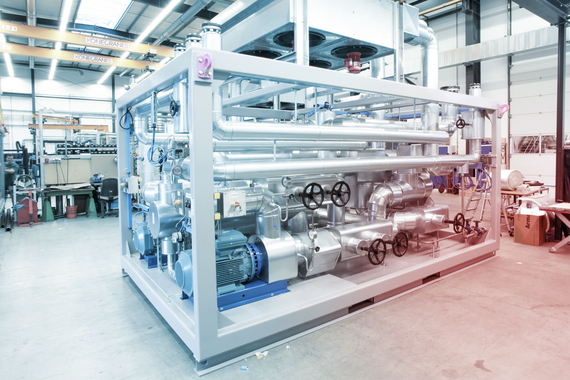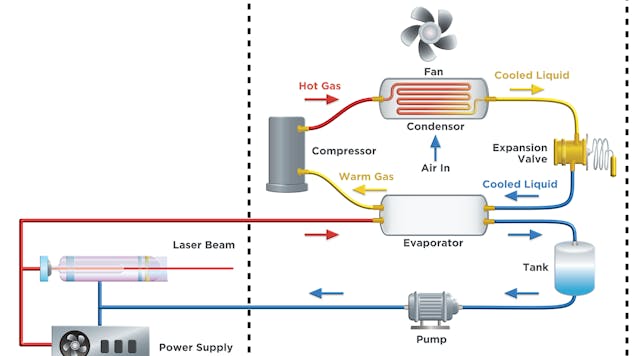How DVS Heat Transfer Systems Are Driving Sustainability Trends in Thermal Engineering
Wiki Article
Technologies in Heat Transfer Solutions: What You Required to Know for Ideal Performance
Developments in Heat transfer systems are transforming efficiency across different industries. Advanced products like graphene and nanofluids promise significant improvements in thermal conductivity. Meanwhile, the assimilation of IoT and maker knowing offers opportunities for real-time monitoring and boosted power efficiency. The landscape of thermal monitoring is quickly progressing. Recognizing these developments is essential for accomplishing excellent system efficiency and sustainability in the future. What specific advancements are forming this transformation?Arising Materials for Enhanced Heat Transfer

Advanced Heat Exchanger Layouts
While traditional Heat exchangers have offered their purpose in various applications, progressed layouts are currently emerging to meet the increasing needs for effectiveness and efficiency. These innovative styles, such as plate, shell-and-tube, and finned-tube Heat exchangers, include boosted surface and enhanced circulation patterns to increase thermal transfer prices. Additionally, compact layouts permit lowered area demands without jeopardizing performance. Advanced products, such as composites and corrosion-resistant alloys, furthermore boost sturdiness and performance under severe problems. Moreover, simulation technologies and computational fluid dynamics are progressively employed to fine-tune these styles, guaranteeing peak Heat transfer features. As industries seek to lessen energy consumption and make best use of result, the fostering of innovative Heat exchanger designs is essential in accomplishing these objectives.The Role of Nanotechnology in Heat Transfer
Nanotechnology plays an essential function in improving thermal conductivity within Heat transfer systems. By manipulating materials at the nanoscale, scientists have actually attained significant renovations in power efficiency. These developments not just optimize performance yet likewise add to more sustainable energy remedies.Improved Thermal Conductivity
Considerable improvements in thermal conductivity have actually emerged with the application of nanotechnology, transforming Heat transfer systems across numerous industries. By incorporating nanoparticles into Heat transfer fluids and products, researchers have actually accomplished amazing boosts in thermal conductivity. These nanoparticles, such as carbon nanotubes, graphene, and steel oxides, boost the Heat transfer properties as a result of their high surface location and distinct thermal attributes. The resulting compounds show improved performance in applications ranging from electronics cooling systems to eco-friendly energy modern technologies. Furthermore, the capability to tailor the size, shape, and structure of nanoparticles enables maximized thermal management services. Therefore, nanotechnology remains to play an essential function in the growth of much more reliable and efficient Heat transfer systems, leading the way for enhanced commercial applications.
Energy Efficiency Improvements

Assimilation of IoT in Heat Transfer Solutions
The combination of IoT in Heat transfer systems introduces the application of clever sensing units that boost functional performance. These sensing units allow real-time information tracking, enabling prompt modifications and optimizations. This technical innovation has the potential to substantially enhance performance and energy management in Heat transfer applications.Smart Sensors Implementation
As Heat transfer systems advance, the combination of wise sensors with the Internet of Points (IoT) has actually emerged as a transformative technique. These sensors enable real-time monitoring of temperature, pressure, and flow rates, improving system performance and dependability. By gathering and transferring information, they facilitate proactive upkeep, reducing the threat of system failures. Additionally, clever sensors add to power financial savings by refining functional specifications based upon environmental problems. Their ability to examine patterns and abnormalities enables informed decision-making, making certain peak efficiency of Heat transfer systems. As industries significantly adopt this innovation, the application of smart sensors stands to reinvent just how Heat transfer systems are handled, leading the way for greater sustainability and boosted efficiency end results.Real-Time Data Monitoring
Exactly how can real-time information monitoring improve the efficiency of Heat transfer systems? By integrating Internet of Things (IoT) technology, Heat transfer systems can take advantage of continuous data collection from wise sensing units. This real-time monitoring permits for prompt analysis of temperature, pressure, and circulation rates, making it possible for drivers to identify ineffectiveness promptly. Changes can be made to maximize performance, lower power intake, and extend tools lifespan. Additionally, look at more info predictive upkeep can be executed, minimizing unanticipated downtime and costly repair services. The ability to imagine efficiency metrics through control panels enhances decision-making, cultivating an aggressive strategy to system administration. Ultimately, real-time data keeping an eye on not just boosts operational effectiveness yet additionally adds to sustainability goals within industrial processes.Power Efficiency and Sustainability Trends
Power efficiency and sustainability patterns are reshaping the landscape of Heat transfer systems, driving advancement and compliance across various markets. Organizations are significantly prioritizing energy-efficient styles to minimize operational expenses and minimize ecological impacts. The assimilation of sustainable power resources is coming to be more common, enabling Heat transfer systems to run sustainably while fulfilling regulatory requirements. Additionally, innovations in products and technologies advertise lower energy intake and boost overall performance. Lifecycle assessments are likewise gaining grip, enabling firms to examine the ecological impact of Heat transfer systems from production to disposal. This focus on sustainability not only supports corporate duty yet also placements organizations competitively in a market where customers progressively favor green options. Energy effectiveness and sustainability continue to be important considerations for future developments in Heat transfer modern technology.Developments in Thermal Monitoring Solutions
While the demand for efficient Heat transfer remains to increase, advancements in thermal management remedies are arising to address both performance and sustainability obstacles. Advanced materials, such as phase change products and nanofluids, are being developed to improve Heat transfer efficiency - DVS Heat Transfer Systems. These materials boost thermal conductivity and enable for much better temperature level regulation in numerous applications. Additionally, innovations like energetic thermal control systems are gaining traction, enabling real-time changes to handle Heat flow effectively. These systems contribute to energy financial savings and minimize the environmental influence of thermal procedures. Additionally, the combination of IoT in thermal management facilitates monitoring and predictive maintenance, making sure optimized efficiency and long life of Heat transfer systems. On the whole, these technologies represent substantial strides towards even more sustainable thermal administration methodsFuture Instructions in Heat Transfer Innovation
Emerging innovations in thermal monitoring options indicate a promising future for Heat transfer technology. Researchers are significantly concentrating on developing materials with exceptional thermal conductivity and boosted energy efficiency. Technologies such as nanofluids, which include put on hold nanoparticles, offer substantial improvements in Heat transfer efficiency. Additionally, the integration of clever materials that adapt to differing temperature conditions is getting traction, permitting more receptive and this content effective systems. The rise of additive production methods is also enabling the design of complicated Heat exchanger geometries that optimize fluid flow. Additionally, the execution of artificial intelligence algorithms is anticipated to revolutionize the optimization of Heat transfer systems, facilitating anticipating upkeep and efficiency improvement. Collectively, these advancements are positioned to change the landscape of Heat transfer innovations in different industries.
Often Asked Questions

Just how Do I Select the Right Heat Transfer System for My Application?
Selecting the ideal Heat transfer system includes assessing application demands, including temperature level varieties, liquid homes, and efficiency needs. Evaluating system kinds, maintenance considerations, and cost-effectiveness additionally plays an important role in making a notified choice.What Are the Upkeep Requirements for Advanced Heat Exchangers?
Upkeep requirements for innovative Heat exchangers commonly include normal inspections, keeping track of for leakages, cleaning of surface areas, and ensuring perfect flow prices. Following producer guidelines warranties effective operation and extends the devices's lifespan.
Exactly How Do Environmental Elements Impact Heat Transfer Efficiency?
Environmental factors considerably affect Heat transfer efficiency. Variants in air movement, temperature level, and humidity influence thermal conductivity and convective Heat transfer, inevitably affecting system performance and requiring factor to consider during the style and procedure of Heat transfer systems.What Security Requirements Relate To Heat Transfer Solutions?
Safety standards for Heat transfer systems commonly include standards from organizations such as ASME and ASTM. DVS Heat Transfer Systems. These requirements address products, design, and operational practices to assure dependability, efficiency, and defense versus threats in different applications
How Can I Fix Typical Heat Transfer System Issues?
Fixing common Heat transfer system problems entails inspecting for leakages, ensuring correct fluid flow, examining insulation honesty, and confirming temperature differentials. Identifying these factors can help keep system efficiency and stop more complications.Nanotechnology plays an essential function in enhancing thermal conductivity within Heat transfer systems. Substantial developments in thermal conductivity this post have actually emerged via the application of nanotechnology, reinventing Heat transfer systems across various industries. Advancements in thermal conductivity with nanotechnology have led the method for amazing enhancements in power effectiveness within Heat transfer systems. Power effectiveness and sustainability patterns are improving the landscape of Heat transfer systems, driving technology and compliance throughout different markets. The assimilation of IoT in thermal monitoring promotes monitoring and anticipating maintenance, making certain maximized performance and durability of Heat transfer systems.
Report this wiki page